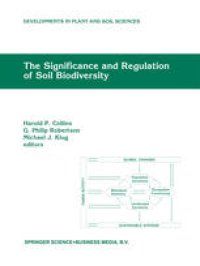
Ebook: The Significance and Regulation of Soil Biodiversity: Proceedings of the International Symposium on Soil Biodiversity, held at Michigan State University, East Lansing, May 3–6, 1993
- Tags: Plant Sciences, Geochemistry, Soil Science & Conservation, Ecology
- Series: Developments in Plant and Soil Sciences 63
- Year: 1995
- Publisher: Springer Netherlands
- Edition: 1
- Language: English
- pdf
The sustainability of both natural and managed ecosystems is strongly influenced by soil biological processes. A major question in soil biology and ecosystem ecology is the extent to which these processes are affected by the function and structure of the soil's biotic community. The Significance and Regulation of Soil Biodiversity presents the discussions of a group of soil biologists and ecosystem ecologists in which they synthesize available information, present innovative methodologies, and develop cross-taxa and cross-habitat collaborations to advance our understanding of soil biodiversity.
The volume addresses the extent and regulation of soil biodiversity and describes initial approaches to the linking of soil biodiversity and ecosystem function.
Audience: Researchers and students in a wide range of environmental scientific disciplines.
The sustainability of both natural and managed ecosystems is strongly influenced by soil biological processes. A major question in soil biology and ecosystem ecology is the extent to which these processes are affected by the function and structure of the soil's biotic community. The Significance and Regulation of Soil Biodiversity presents the discussions of a group of soil biologists and ecosystem ecologists in which they synthesize available information, present innovative methodologies, and develop cross-taxa and cross-habitat collaborations to advance our understanding of soil biodiversity.
The volume addresses the extent and regulation of soil biodiversity and describes initial approaches to the linking of soil biodiversity and ecosystem function.
Audience: Researchers and students in a wide range of environmental scientific disciplines.
The sustainability of both natural and managed ecosystems is strongly influenced by soil biological processes. A major question in soil biology and ecosystem ecology is the extent to which these processes are affected by the function and structure of the soil's biotic community. The Significance and Regulation of Soil Biodiversity presents the discussions of a group of soil biologists and ecosystem ecologists in which they synthesize available information, present innovative methodologies, and develop cross-taxa and cross-habitat collaborations to advance our understanding of soil biodiversity.
The volume addresses the extent and regulation of soil biodiversity and describes initial approaches to the linking of soil biodiversity and ecosystem function.
Audience: Researchers and students in a wide range of environmental scientific disciplines.
Content:
Front Matter....Pages I-2
Front Matter....Pages 3-3
A Hierarchical approach to evaluating the significance of soil biodiversity to biogeochemical cycling....Pages 5-22
Mutualism and biodiversity in soils....Pages 23-33
The detritus food-web and the diversity of soil fauna as indicators of disturbance regimes in agro-ecosystems....Pages 35-43
Front Matter....Pages 45-45
Patterns and regulation of mycorrhizal plant and fungal diversity....Pages 47-62
Thoughts on the processes that maintain local species diversity of ectomycorrhizal fungi....Pages 63-73
Soil microbial diversity and the sustainability of agricultural soils....Pages 75-86
The functional significance of the microbial biomass in organic and conventionally managed soils....Pages 87-97
Fatty acid methyl ester (FAME) profiles as measures of soil microbial community structure....Pages 99-113
Discrimination of microbial diversity by fatty acid profiles of phospholipids and lipopolysaccharides in differently cultivated soils....Pages 115-122
Effects of previous intensive agricultural management on microorganisms and the biodiversity of soil fauna....Pages 123-129
Divergence of mycorrhizal fungal communities in crop production systems....Pages 131-140
Biodiversity and species redundancy among litter decomposers....Pages 141-151
The role of glutamine synthetase in regulation of nitrogen metabolism within the soil microbial community....Pages 153-159
Facultatively anaerobic cellulolytic fungi from soil....Pages 161-167
Interpreting soil ciliate biodiversity....Pages 169-177
Front Matter....Pages 179-184
Measures of nematode community structure and sources of variability among and within agricultural fields....Pages 185-185
Analysis of nematode trophic structure in agroecosystems: Functional groups versus high resolution taxonomy....Pages 187-201
Relationships among microarthropods, fungi, and their environment....Pages 203-207
The spatial heterogeneity of soil invertebrates and edaphic properties in an old growth forest stand in western Oregon....Pages 209-223
Front Matter....Pages 225-236
Population dynamics and functional roles of Enchytraeidae (Oligochaeta) in hardwood forest and agricultural ecosystems....Pages 185-185
How do earthworms affect microfloral and faunal community diversity?....Pages 237-245
Earthworm community structure and diversity in experimental agricultural watersheds in Northeastern Ohio....Pages 247-269
Earthworm population size and composition, and microbial biomass: Effect — of pastoral and arable management in Canterbury, New Zealand....Pages 271-277
Leaf litter decomposition and microarthropod abundance along an altitudinal gradient....Pages 279-285
Back Matter....Pages 287-292
....Pages 293-294